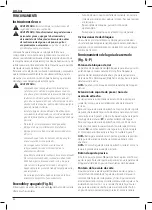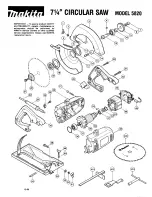
50
EnGLIsh
Compound Mitre
This cut is a combination of a mitre and a bevel cut. Set the
bevel to the angle required and proceed as for a cross-cut mitre.
Support for Long Pieces
• Always support long pieces.
• Support long workpieces using any convenient means
such as saw-horses or similar devices to keep the ends
from dropping.
Non-Through-Cutting
(Grooving and Rabbeting)
WARNING:
Remove the blade guard assembly
11
and
install the non-through-cutting riving knife
52
for non-
through-cutting operations. Use featherboards for all
non-through-cutting operations where the blade guard
assembly, anti-kickback assembly and riving kife cannot
be used.
Instructions in the
Ripping, Crosscutting, Bevel Crosscutting,
Mitreing
, and
Compound Mitreing
sections are for cuts
made through the full thickness of the material. The saw can
also perform non-through cuts to form grooves or rabbets in
the material.
Non-Through-Ripping (Fig. D, U)
WARNING:
A rip fence should
ALWAYS
be used for
ripping operations to prevent loss of control and personal
injury.
NEVER
perform a ripping operation freehand.
ALWAYS
lock the fence to the rail.
WARNING:
When bevel ripping and whenever possible,
place the fence on the side of the blade so that the blade is
tilted away from the fence and hands.
WARNING:
Keep hands clear of the blade. With non-
through-cutting the blade is not always visible during the
cut, so increased caution is necessary to ensure hands are
clear of the blade.
WARNING:
Use a push stick to feed the workpiece if there
are 51–152 mm between the fence and the blade. Use a
narrow ripping fence feature and push block to feed the
workpiece if there are 51 mm or narrower between the
fence and the blade.
1. Remove the blade guard assembly
11
and install the non-
through-cutting riving knife
52
(Fig. D). Refer to:
Mounting
the Blade Guard Assembly/Riving Knife
.
2. Lock the rip fence by pressing the rail lock lever down.
Remove the mitre gauge.
3. Raise the blade to the desired cut depth.
4. Hold the workpiece flat on the table and against the fence.
Keep the workpiece about 25.4 mm away from the blade.
WARNING:
The workpiece must have a straight edge
against the fence and must not be warped, twisted or
bowed. Keep both hands away from the blade and away
from the path of the blade. See proper hand position in
Figure U.
5. Turn the saw on and allow the blade to come up to speed.
Both hands can be used in starting the cut. When there
are approximately 305 mm left to be ripped, use only one
hand, with your thumb pushing the material, your index and
second finger holding the material down and your other
fingers hooked over the fence. Always keep your thumb
along side your first two fingers and near the fence.
6. Keeping the workpiece against the table and fence, slowly
feed the workpiece rearward all the way through the saw
blade. Continue pushing the workpiece until it is clear of the
blade guard assembly and it falls off the rear of the table. Do
not overload the motor.
7. Never try to pull the workpiece back with the blade turning.
Turn the switch off, allow the blade to stop and slide the
workpiece out.
8. When sawing a long piece of material or a panel, always use
a work support. A sawhorse, rollers, or out feed assembly
provides adequate support for this purpose. The work
support must be at the same height or slightly lower than
the saw table.
Non-Through-Ripping Small Pieces (Fig. A)
It is unsafe to rip small pieces. It is not safe to put your hands
close to the blade. Instead, rip a larger piece to obtain the
desired piece. When a small width is to be ripped and the hand
cannot be safely put between the blade and the rip fence, use
one or more push sticks. A push stick
21
is included with this
saw, attached to the rip fence. Use the push stick(s) to hold the
workpiece against the table and fence, and push the workpiece
fully past the blade.
Non-Through-Bevel Ripping (Fig. V)
This operation is the same as non-through-cut ripping except
the bevel angle is set to an angle other than zero degrees. For
proper hand position, Refer to Figure V.
WARNING:
Before connecting to power source or
operating the saw, always inspect the riving knife for
proper alignment and clearance with saw blade. Check
alignment after each change of bevel angle.
Non-Through-Crosscutting (Fig. W)
WARNING:
NEVER
use rip fence in combination with
mitre gauge.
WARNING:
To reduce the risk of injury,
NEVER
use the
fence as a guide or length stop when crosscutting.
WARNING:
When using a block as a cut-off gauge,
the block must be at least 19 mm thick and is very
important that the rear end of the block be positioned
so the workpiece is clear of the block before it enters the
blade to prevent contact with blade resulting in a thrown
workpiece and possibly injury.
1. Remove the rip fence and place the mitre gauge in the
desired slot.
2. Adjust the blade height to the desired cut depth.
3. Hold the workpiece firmly against the mitre gauge
10
with
the path of the blade in line with the desired cut location.
Keep the workpiece an inch or so in front of the blade. KEEP
BOTH HANDS AWAY FROM THE BLADE AND THE PATH OF
THE BLADE (Fig. W).
Summary of Contents for DWE7492
Page 1: ...DWE7492 Final Page size A5 148mm x 210mm ...
Page 3: ...1 Fig B 9 20 14 50 19 52 21 13 15 2 Fig A 5 18 4 19 17 8 7 6 10 3 12 1 50 11 16 51 ...
Page 4: ...2 Fig C Fig F Fig E 30 18 40 25 26 16 Fig D 12 2 11 20 23 22 24 2 29 52 13 ...
Page 6: ...4 Fig M Fig P Fig N Fig Q 8 27 Fig O 5 20 29 4 28 ...
Page 7: ...5 Fig R Fig S Fig V Fig T Fig U 42 44 45 ...
Page 8: ...6 Fig X Fig W Fig AA Fig Y Fig Z 21 43 18 Lore 10 11 10 46 ...
















































